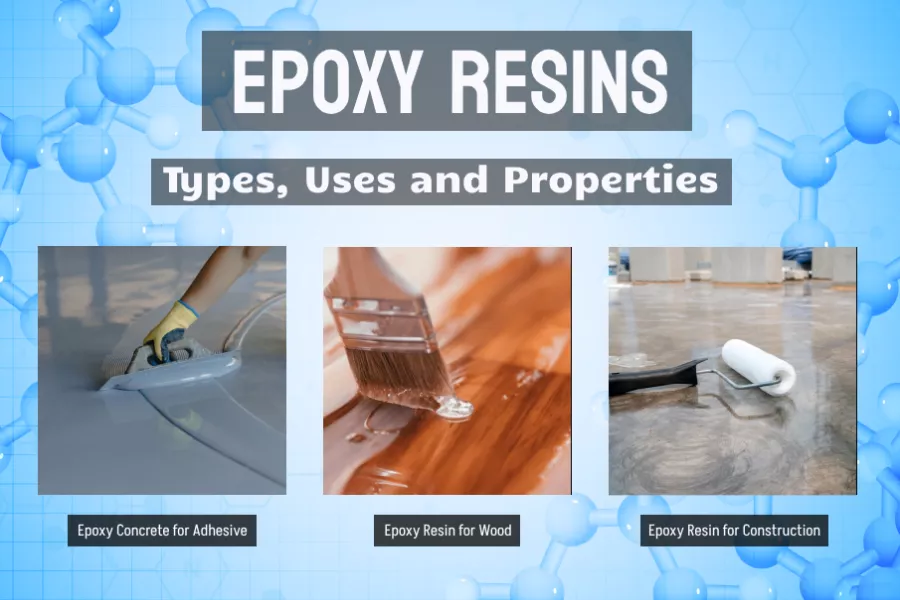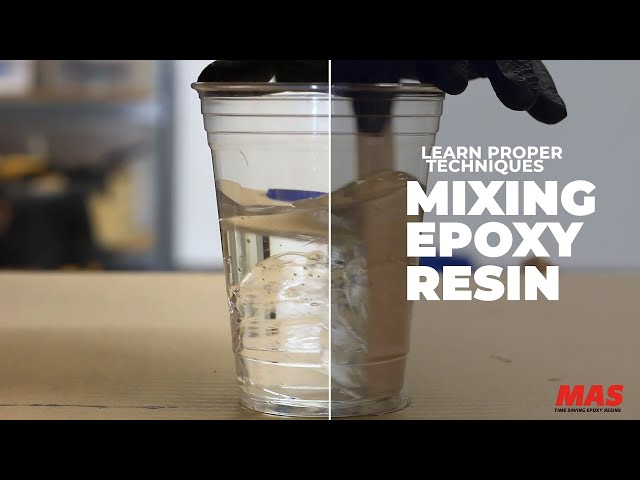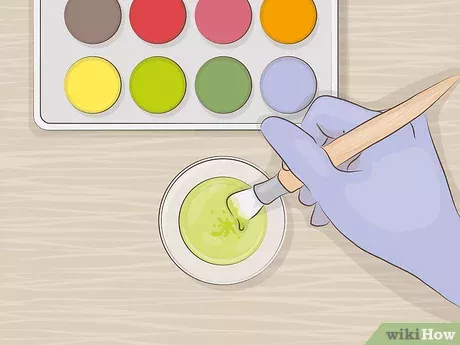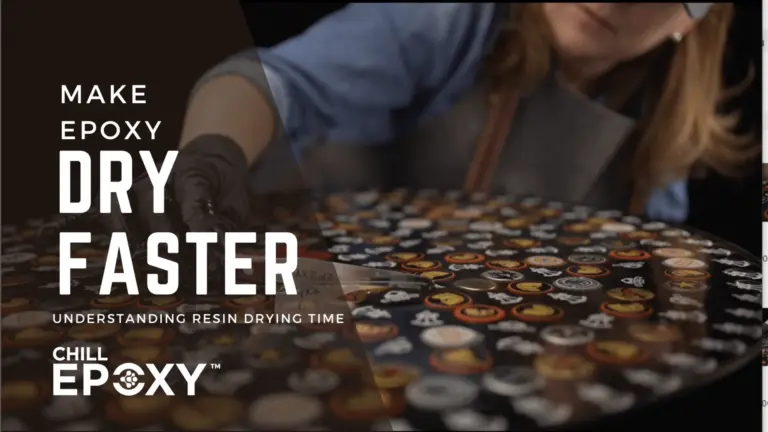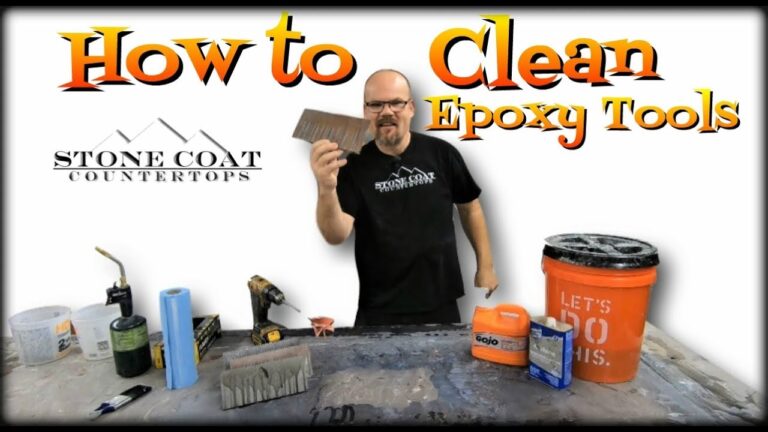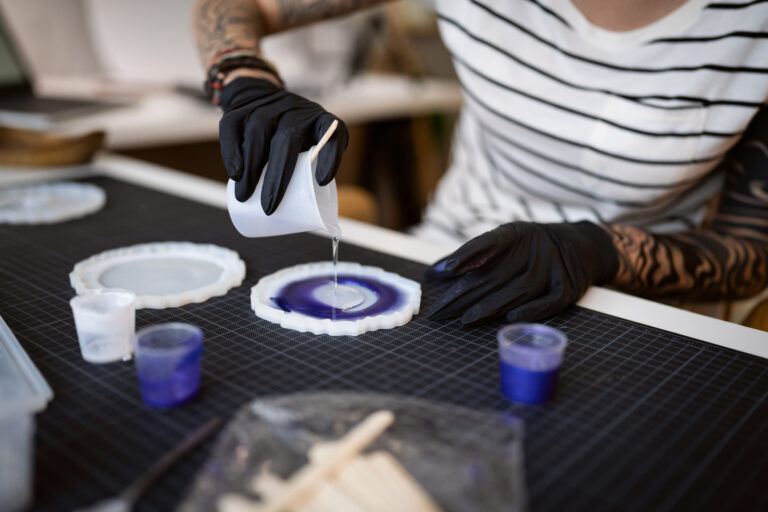What Is Epoxy Resin: Definition and Applications
Understanding Epoxy Resin
To truly grasp the versatility of epoxy resin, it’s crucial to understand its definition and composition, as well as the various industrial applications it serves.
Definition and Composition
Epoxy resin, often called polyepoxide, is a type of reactive polymer that consists of two main components: a viscous liquid resin and a chemical hardener. When these components are mixed, they rapidly cure into a hardened plastic with exceptional strength, chemical resistance, and dimensional stability (Copps Industries). The chemical structure of epoxy resin typically involves the reaction of epichlorohydrin with bisphenol A, creating bisphenol A diglycidyl ethers. Additionally, other bisphenols or brominated bisphenols can be used to modify the resin and achieve varied properties, such as enhanced chemical resistance (Wikipedia).
| Component | Function |
|---|---|
| Liquid Resin | Reacts with hardener to solidify |
| Chemical Hardener | Catalyzes the curing process |
Industrial Applications
Epoxy resin plays a significant role across various industries due to its wide range of applications and robust properties.
Composite Materials Manufacturing
In the realm of composite materials, epoxy resin is extensively used, particularly with carbon fiber. This combination results in composites that exhibit enhanced mechanical strength, high-temperature resistance, and chemical resistance (Copps Industries). Such properties make epoxy-based composites ideal for manufacturing everything from sports equipment to aerospace components.
| Application | Key Benefit |
|---|---|
| Carbon Fiber Composites | Enhanced strength and resistance |
Electronics Industry Use
Within the electronics industry, epoxy resin is indispensable for safeguarding circuit boards and electronic components. By protecting these components from dust, moisture, and heat, epoxy resin significantly improves the lifespan and reliability of electronic devices. It’s commonly used as an encapsulant or potting material, ensuring stable and reliable performance.
| Application | Key Benefit |
|---|---|
| Circuit Board Protection | Improved lifespan and reliability |
Epoxy resin’s versatility extends beyond composite materials and electronics. It is also widely used in metal coatings, high-tension electrical insulators, paintbrush manufacturing, and fiber-reinforced plastic materials. Moreover, it serves as an adhesive for a variety of structural and other purposes.
For home renovators, epoxy resin is a valuable tool that can be used in a multitude of projects. Whether you’re looking to coat a surface, create a durable finish, or even bond components together, epoxy resin can be an excellent choice. Learn more about how to use epoxy resin effectively in our guide on how to use epoxy resin and ensure you know how to remove epoxy resin if needed.
For more information on the diverse uses and properties of epoxy resin, check out related content on our site:
Understanding the foundational aspects of epoxy resin will empower you to utilize this versatile material in your next project effectively.
Properties of Epoxy Resin
When you think about what epoxy resin is, it’s essential to consider its key properties, which make it a versatile and reliable material for various applications. Two such important properties are its strength and durability, as well as its chemical and heat resistance.
Strength and Durability
Epoxy resin is known for its exceptional strength and durability. Once cured, it forms a hardened plastic that boasts high mechanical stability and an impressive ability to withstand significant stress without breaking. This makes it an excellent choice for construction and repair projects around your home.
| Property | Value |
|---|---|
| Tensile Strength | 7,000-10,000 psi |
| Compressive Strength | 11,000-14,000 psi |
| Flexural Strength | 16,000-22,000 psi |
| Impact Resistance | 0.4-0.6 ft-lbs/in |
Epoxy’s strength and durability are enhanced through its application in composite materials manufacturing, particularly when combined with substances like carbon fiber (Copps Industries). This combination yields composites with superior mechanical properties and durability.
Chemical and Heat Resistance
In addition to its structural strength, epoxy resin excels in its resistance to chemical and thermal influences. This makes it incredibly useful in environments where exposure to harsh substances or high temperatures is a concern. Per Copps Industries, epoxy’s ability to adhere to various substrates such as glass, metal, wood, and more adds to its versatility and application in numerous settings.
Epoxy’s heat resistance is particularly notable, making it ideal for applications exposed to high temperatures. However, remember that temperature can influence the curing process, with higher heat accelerating and lower temperatures slowing down the curing (Powerblanket).
For more information on epoxy resin’s heat resistance, check out is epoxy resin heat resistant.
Epoxy resin’s chemical resistance allows it to be stable in the presence of various chemicals, enhancing its longevity and reliability in demanding environments. This property is why it’s frequently used in industrial settings, marine applications, and even electronics.
Using epoxy resin for various projects ensures durability and resilience. If you need to understand how to handle epoxy resin properly, learn more about how to use epoxy resin or how to cure epoxy resin for optimal results.
Epoxy Resin in Different Industries
Epoxy resin is a versatile material with a wide range of applications across various industries. Here, we will explore its use in composite materials manufacturing and the electronics sector.
Composite Materials Manufacturing
Epoxy resin plays a crucial role in the production of composite materials, particularly when combined with carbon fiber. These composites are known for their exceptional mechanical strength, high-temperature resistance, and chemical durability (Copps Industries). This makes them ideal for applications that require robust and lightweight materials, such as aerospace, automotive, and sports equipment.
| Property | Benefit |
|---|---|
| Mechanical Strength | Enhanced durability |
| High-Temperature Resistance | Suitable for extreme environments |
| Chemical Resistance | Long-lasting and maintenance-free |
Composites created with epoxy resin offer unparalleled performance compared to traditional materials. If you’re interested in using epoxy for your next DIY project, check out our guide on how to epoxy resin a table top.
Electronics Industry Use
In the electronics industry, epoxy resin is commonly used to protect and insulate circuit boards and other electronic components. This serves to shield delicate parts from dust, moisture, and heat, thereby increasing the lifespan and reliability of electronic devices.
| Application | Purpose |
|---|---|
| Circuit Board Coating | Protection from environmental factors |
| Component Encapsulation | Enhanced durability and reliability |
| Potting | Secure and insulate electronic parts |
Epoxy resin’s ability to form a strong, protective barrier makes it an essential material in the manufacture of modern electronics. For more information on how to work with epoxy resin in electronics, see our article on how to use epoxy resin.
Understanding the diverse applications of epoxy resin helps you appreciate its importance across various fields. Whether you’re planning a DIY home renovation or are curious about industrial uses, epoxy resin offers solutions that cater to both professional and personal projects. For additional resources, explore our articles on how to remove epoxy resin and how to add color pigment to epoxy resin.
Applications in Automotive and Transportation
Epoxy resin’s durability, strength, and resistance properties make it a preferred material within the automotive and transportation industry. Below we discuss its specific uses for repair, coating, and bonding of components.
Repair and Coating
Epoxy resin is widely used in the industry for its ability to repair and coat various auto parts efficiently. Whether you’re dealing with minor dings or severe rust damage, epoxy resin offers a reliable solution. It’s particularly effective for:
- Body Repairs: Epoxy resin can fill dents, holes, and scratches on the car’s exterior.
- Rust Protection: When applied as a coating, it protects metal parts from corrosion, extending the life of vehicle components.
- Surface Smoothing: A coat of epoxy resin can smooth out rough surfaces, preparing them for paint application.
| Function | Benefits |
|---|---|
| Body Repairs | Fills dents and scratches |
| Rust Protection | Prevents corrosion |
| Surface Smoothing | Prepares for paint application |
For more information on safely using epoxy resin, check our article on how to use epoxy resin.
Bonding of Components
Epoxy resin is well-known for its superior bonding capabilities, making it ideal for assembling various automotive parts (WEST SYSTEM). Here are some specific applications:
- Frame Assembly: Strong bonds between metal components enhance the structural integrity of the vehicle.
- Component Attachment: Parts such as panels, trims, and spoilers can be securely fixed using epoxy adhesive.
- Interior Fixings: Secure attachment of internal elements like dashboards, consoles, and other fixtures.
| Application | Benefit |
|---|---|
| Frame Assembly | Enhances structural integrity |
| Component Attachment | Secure fixing of parts |
| Interior Fixings | Durable attachment of internal elements |
Epoxy’s effectiveness in bonding is due to its robust adhesion and resistance to environmental conditions, making it indispensable in automotive manufacturing and repairs (KSResin).
For best practices when using epoxy resin in repair and bonding, refer to our guide on how to mix epoxy resin and ensure you follow all safety protocols. If you need to remove epoxy resin from surfaces, we also have an article on how to remove epoxy resin.
Epoxy Resin in Marine Industry
Epoxy resin is an essential material in the marine industry due to its remarkable properties. Whether you’re building a boat or performing repairs, epoxy offers exceptional benefits. Let’s explore its applications in sealing and coating, as well as its use as a structural adhesive.
Sealing and Coating
In the marine industry, protecting the integrity of boats from harsh environmental conditions is crucial. Epoxy resin is commonly used for sealing and coating purposes. Its resistance to salt, water, and environmental harshness makes it a popular choice (Copps Industries).
Epoxy resin is often applied as a protective coating on boat hulls, decks, and other exposed surfaces. This helps enhance the boat’s durability and longevity, preventing water ingress and corrosion. Additionally, it can be used to safeguard electronic components and circuit boards from dust, moisture, and heat (Copps Industries).
| Application | Function |
|---|---|
| Boat Hulls | Water resistance and corrosion prevention |
| Decks | Durability enhancement |
| Electronic Components | Moisture and heat protection |
Structural Adhesive Use
Epoxy resin’s strong adhesive properties make it an invaluable material for structural applications in the marine industry. It is often used to bond various parts and components of boats, providing a sturdy and reliable connection.
When used as a structural adhesive, epoxy resin can effectively bond different materials such as wood, fiberglass, metals, and composites. Its strong bond ensures that components stay securely in place, even under extreme marine conditions. For intricate bonding tasks, you might need to consider the mix ratio, commonly 4:1 or 2:1 resin-to-hardener ratio, to achieve optimal results (Sakshi Chem Sciences).
For home renovators interested in the broader spectrum of epoxy resin applications, exploring how to use epoxy resin in various settings can be enlightening. If you’re curious about the epoxy resin curing process, learning how to cure epoxy resin can provide valuable insights.
| Bonding Application | Materials |
|---|---|
| Hull Panels | Wood, fiberglass |
| Deck Structures | Metals, composites |
| Component Attachments | Various marine-grade materials |
Make sure to follow proper guidelines and safety measures when working with epoxy resin. You can read more about safeguarding practices in our guide on how to clean epoxy resin off tools.
Using epoxy resin in the marine industry offers various advantages, ensuring the longevity and robustness of your projects, whether they’re big or small. Discover more about the fascinating world of epoxy resin and its myriad applications by delving further into subjects like what are some good polishers for epoxy resin and how to remove epoxy resin.
The Chemistry of Epoxy Resin
For home renovators, understanding the chemistry of epoxy resin can help you make informed decisions when working on projects. Here, you’ll explore its basic components and the curing process.
Basic Components
Epoxy resin is composed of two main ingredients: bisphenol and epichlorohydrin.
- Bisphenol: This is a combination of acetone and phenol, typically bisphenol A (BPA), but other bisphenols can also be used.
- Epichlorohydrin: This is derived from allyl chloride, a sub-chemical of propylene (Powerblanket).
These components react to form bisphenol A diglycidyl ether, the base for most epoxy resins.
Curing Process
The curing process of epoxy resin involves a chemical reaction between the resin and a hardener, creating a strong and durable material.
- Mixing: When you mix the resin and hardener, a chemical reaction called polymerization begins.
- Heat Generation: As the reaction progresses, heat is produced. This can cause the mixture to harden quickly if not monitored properly.
- Time: The curing time can vary based on the type of epoxy and conditions. Some resins are slow-curing, allowing for deeper pours, which are ideal for projects like resin river tables (Just Resin).
Curing Stages
| Stage | Description |
|---|---|
| Liquid | The resin is fully mixable and workable. |
| Gel Phase | The mixture becomes thicker and starts to set. |
| Solid Phase | The resin is hard but may still be soft to touch. |
| Fully Cured | The resin reaches full mechanical properties. |
During the curing process, you should avoid mixing more resin than recommended by the manufacturer to prevent overheating and premature hardening (Just Resin).
Understanding the basic components and curing process will make you more adept at using epoxy resin for various applications, whether sealing sand in epoxy resin, adding color pigment, or removing epoxy resin from surfaces. For additional insights, visit our guides on how to cure epoxy resin and how to use epoxy resin.
Factors Affecting Epoxy Resin Curing
When it comes to understanding what is epoxy resin and its curing process, temperature plays a significant role. Additionally, the use of heat blankets can be crucial in achieving optimal results.
Temperature Influence
Temperature can significantly influence the curing process of epoxy resin. The warmer the temperature, the faster the curing process occurs. Increased heat accelerates the chemical reactions between the resin and hardener, speeding up the curing time (WEST SYSTEM). Conversely, cold temperatures slow down the curing process, making the epoxy resin less effective if applied directly from a cold container.
| Temperature (°F) | Curing Time (Hours) |
|---|---|
| 50°F | 72 |
| 60°F | 48 |
| 70°F | 24 |
| 80°F | 12 |
| 90°F | 6 |
Control over the curing temperature is essential to prevent unwanted effects. Excessive heat can cause the epoxy to overheat, potentially leading to cracks and bubbles in the final product (Just Resin). To manage this, using the appropriate hardeners for the temperature is recommended. For cool conditions, faster hardeners or supplemental heat sources are useful, while slower hardeners are ideal for warm conditions.
Heat Blanket Utilization
Heat blankets offer an economical and efficient method for curing epoxy resins. These blankets provide even heat distribution, tight temperature control, and insulation to prevent heat loss, making them an ideal choice for both home renovators and businesses on a budget.
Benefits of Heat Blankets:
- Even heat distribution
- Tight temperature control
- Prevention of heat loss
- Economical and efficient
- Ideal for large-scale and small projects
Applying a heat blanket can ensure uniform curing, minimize the risk of overheating, and help achieve a consistent finish. The use of heat blankets can be especially beneficial for projects requiring a controlled environment or for curing large surfaces.
By understanding how temperature and heat blankets affect the curing process, you can better manage your epoxy resin projects and achieve higher-quality results. For additional tips on working with epoxy resin, you can refer to our articles on how to use epoxy resin and how to mix epoxy resin.
Epoxy Resin Curing Process
Transformation Phases
When you think about what is epoxy resin, understanding its curing process is essential. Epoxy resin, when mixed with a hardener, undergoes a chemical reaction that transforms it from a combined liquid state to a solid state. This process can be broken down into several transformation phases.
-
Liquid Phase: Initially, the epoxy resin and hardener are in a liquid state. During this phase, the resin is mixed and applied to the desired surface.
-
Gel Phase: As the chemical reaction progresses, the mixture begins to gel. This is often referred to as the “green” stage. The resin is no longer fluid, but it is not fully hardened either.
-
Solid Phase: The final phase is where the epoxy resin becomes a solid. At this point, it reaches about 90% of its ultimate strength, allowing you to remove clamps or other supports used during application.
These phases play a critical role in determining how and when you can proceed with your project. For more detailed information on the mixing and application process, check out our guide on how to mix epoxy resin.
Curing Duration
The curing duration of epoxy resin is another vital aspect to consider. It consists of two main stages (WEST SYSTEM):
-
Open Time (Working Time): This is the period during which the resin can be mixed, applied, and clamped. It typically lasts from several minutes to a few hours, depending on the type of hardener used and the ambient temperature.
-
Cure Time: After the open time, the mixture will need time to cure completely. The final cure can take several days at room temperature. However, the epoxy will be about 90% cured within the first 24 hours, after which you may proceed with additional steps like sanding or painting. For more on painting over resin, see can you paint over epoxy resin.
| Stage | Duration | Description |
|---|---|---|
| Open Time | Few minutes to hours | Mixing, application, clamping |
| Initial Cure Time | 24 hours | Achieves 90% strength |
| Full Cure Time | Several days | Complete curing, ready for further processing |
The temperature during the curing process significantly impacts the curing duration. Warmer temperatures accelerate the chemical reaction, thus reducing the cure time. Conversely, colder temperatures slow down the reaction (Powerblanket).
To ensure optimal results, consider using heat blankets or controlled temperature environments, particularly if you’re working under variable conditions. For more related tips, check out our article on how to cure epoxy resin.
By understanding the transformation phases and curing duration, you can effectively plan and execute your projects involving epoxy resin. For more insights on cleaning and maintaining tools, visit how to clean epoxy resin off tools.
Types of Epoxy Resins
When choosing the best epoxy resin for your project, it helps to understand the different types available. Epoxy resins are primarily categorized into glycidyl and non-glycidyl resins. Knowing the differences and common categories will help you make an informed decision.
Glycidyl vs Non-Glycidyl
Epoxy resins can be divided into two major categories: glycidyl and non-glycidyl.
Glycidyl Resins
Glycidyl resins are further subdivided into three types: glycidyl-ethers, glycidyl-esters, and glycidyl-amines.
- Glycidyl-Ethers: The most common type of glycidyl resins, often used in a wide range of applications due to their flexibility and chemical resistance.
- Glycidyl-Esters: These are less common but offer unique properties such as enhanced resistance to acids.
- Glycidyl-Amines: Known for their high-temperature performance and mechanical strength.
Non-Glycidyl Resins
Non-glycidyl resins include aliphatic and cyclo-aliphatic resins.
- Aliphatic Epoxy Resins: Known for their UV resistance and are often used in outdoor applications.
- Cyclo-Aliphatic Resins: These offer excellent electrical insulation properties making them ideal for electronic components.
For a deeper dive into the chemistry behind these types, visit our page on what is epoxy resin made of.
Common Epoxy Resin Categories
Several classes of epoxy resins are frequently used in various industries. Here are some of the most popular:
| Type of Epoxy Resin | Characteristics | Applications |
|---|---|---|
| Bisphenol Epoxy Resins | High strength, excellent bond with different materials (Sakshi Chem Sciences) | Coatings, adhesives, composites |
| Aliphatic Epoxy Resins | UV stable, good for outdoor use (RS Online) | Outdoor coatings, adhesives, sealants |
| Novolac Epoxy Resins | Enhanced chemical and heat resistance (RS Online) | Linings, coatings, adhesives |
| Halogenated Epoxy Resins | Flame retardant properties (Sakshi Chem Sciences) | Electrical laminates, coatings |
| Epoxy Resin Diluents | Lower viscosity, modify final properties (RS Online) | Specialty coatings, adhesives |
| Glycidylamine Epoxy Resins | High-temperature performance, mechanical strength (Wikipedia) | High-performance composites, electronic components |
Learning about these different types of epoxy resins will guide you in selecting the perfect one for your needs. From general household repairs and how to epoxy resin a table top to specialized applications like how to remove epoxy resin from metal, you can now confidently choose the epoxy resin that best suits your project.

